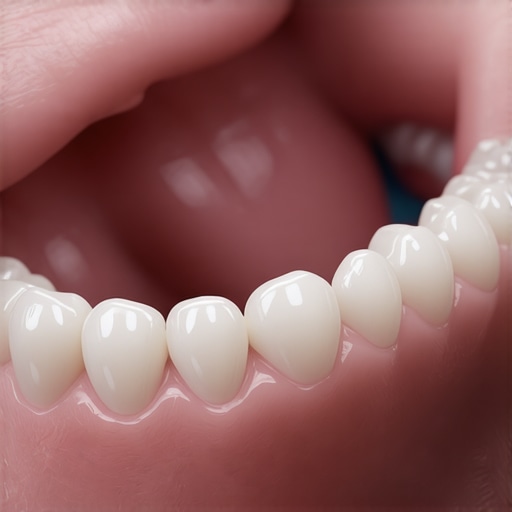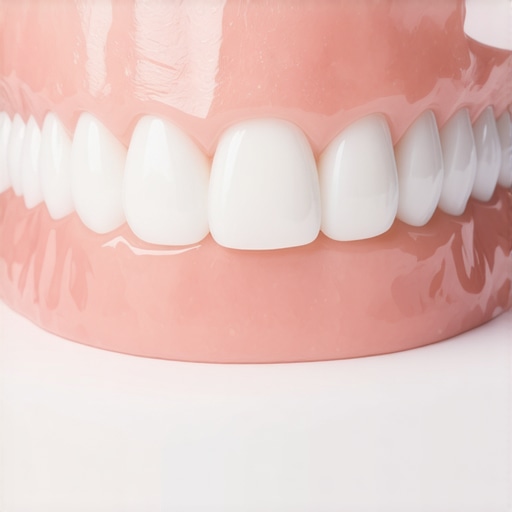My Personal Journey into Family Dentistry and the Power of Crowns
It all started a few years ago when I noticed my smile was losing its sparkle. A chipped tooth and persistent discomfort made me realize I needed to revisit my family dentist. That visit transformed my perspective on dental care, especially the importance of crowns in restoring not just my teeth but my confidence.
Why I Chose Crowns for My Dental Restoration
During my consultation, my dentist explained how crowns serve as a reliable solution for damaged or decayed teeth. They act as a protective cover, restoring the tooth’s shape, size, and function. I appreciated that modern crowns look natural and blend seamlessly with my existing teeth, making me feel more confident in my smile.
The Experience of Getting a Crown: What I Learned
The process was surprisingly comfortable. After preparing my tooth, the dentist placed a custom-made crown. I was amazed at how precisely it fit and how natural it looked. I also learned that crowns are not just about aesthetics but also about long-term oral health. They prevent further decay and help maintain bite alignment, which is crucial for overall oral function.
How Crowns Improve Family Dental Care
Seeing the positive impact on my own health, I realized how vital crowns are in family dentistry. They offer a durable, effective solution for various dental issues, from cracked teeth to root canals. For families, choosing trusted dental solutions like crowns ensures everyone maintains a healthy, confident smile.
What Makes a Crown a Game-Changer in Restorative Dentistry?
From my research, I found that crowns have revolutionized how dentists approach restorative procedures. They provide a strong, long-lasting repair that can last 10-15 years with proper care. Plus, advances in materials like porcelains and ceramics mean they look incredibly natural. For more insights, I recommend reading this comprehensive guide.
How Do I Know If a Crown Is the Right Solution for My Dental Needs?
Deciding on a crown depends on your specific condition. If you have a damaged, decayed, or cracked tooth, or need a root canal filling, crowns are often the best choice. Consulting with a trusted family dentist can help determine if a crown suits your situation. They’ll evaluate factors like tooth structure, bite, and aesthetic goals to recommend the optimal solution.
If you’re curious about how crowns can improve your family’s oral health, don’t hesitate to reach out through our contact page. Sharing your experiences or questions can help others find the right dental solutions for their needs.
For additional tips on maintaining a healthy smile, check out this article. Remember, investing in family dental health today paves the way for a brighter, more confident tomorrow.
Understanding the Nuances of Dental Crown Materials
One of the most fascinating aspects of modern dentistry is the variety of materials used for crowns. From traditional porcelain-fused-to-metal (PFM) options to advanced all-ceramic and zirconia crowns, each material offers distinct advantages. Choosing the right crown material depends on factors like the location of the tooth, aesthetic demands, and functional requirements. For instance, zirconia crowns are renowned for their exceptional strength and are ideal for molars, while all-ceramic crowns excel in front teeth due to their superior translucency and natural appearance.
The Role of Digital Dentistry in Crown Fabrication
Digital technology has revolutionized how crowns are designed and manufactured. With 3D imaging and CAD/CAM systems, dentists can create highly precise restorations that fit seamlessly into a patient’s bite. This process not only enhances accuracy but also reduces the time from consultation to placement. For those interested in contemporary advancements, exploring how digital dentistry is shaping family dental care can provide insightful context on integrated restorative solutions.
Expert Tips for Long-Lasting Crown Care
Maintaining your dental crowns requires diligent oral hygiene and regular dental visits. Avoiding hard foods and grinding habits can extend the lifespan of your restoration. Use a soft-bristled toothbrush and non-abrasive toothpaste to prevent surface wear. Additionally, scheduling routine check-ups allows your dentist to monitor the crown’s condition and address any issues early. For comprehensive guidance, consider reviewing top oral health tips for your family’s bright smiles.
What Are the Practical Implications of Choosing a Crown Over Other Restorations?
When evaluating options like fillings, inlays, or veneers, crowns often stand out for their durability and versatility. Crowns can restore severely damaged teeth, provide support for dental bridges, and even serve as a foundation for dental implants. Their ability to encapsulate a tooth offers unparalleled protection against further decay or fracture. An expert consideration is whether a crown’s benefits outweigh its invasiveness, which can be discussed thoroughly with your trusted family dentist. To explore how crowns compare with other treatments, visit this resource on restorative options.
How Might Emerging Technologies Further Enhance Crown Longevity and Aesthetics?
Emerging innovations such as bioceramic materials and nanotechnology are paving the way for even more durable and lifelike crowns. These advancements promise to improve biocompatibility, reduce wear, and enhance aesthetic outcomes. Dentists are increasingly adopting these cutting-edge solutions to provide patients with restorations that last longer and look more natural. As an expert, I recommend staying informed about these developments by following trusted sources like the American Dental Association or leading dental research publications. For example, insights from authoritative sources like ADA’s latest updates on dental materials can guide you in understanding future trends.
If you’re eager to learn more about how innovative crown solutions can transform your smile, don’t hesitate to ask your family dentist. Sharing your questions and experiences can also help others seeking personalized dental care advice. For further reading, explore this article on Invisalign crowns transforming smiles.
Exploring the Intricacies of Crown Materials: Beyond the Surface
As I delved deeper into the world of dental crowns, I realized that the choice of material isn’t just about aesthetics or strength; it’s about understanding the complex interplay between biocompatibility, durability, and patient-specific needs. For instance, bioceramic materials have emerged as promising options, offering enhanced integration with natural tissues and reducing allergic reactions. This nuanced understanding underscores the importance of personalized treatment plans, which I believe are at the heart of truly effective family dentistry.
Personalizing Crown Selection: More Than Just a Technical Decision
In my experience, selecting the perfect crown involves a detailed assessment of lifestyle, oral habits, and even genetic predispositions. For example, a patient who grinds their teeth might benefit from a zirconia crown’s superior strength, while someone prioritizing aesthetics might prefer a porcelain crown that mimics natural translucency. This tailored approach not only prolongs the lifespan of the restoration but also enhances overall satisfaction—a principle I hold dear as a dental professional committed to holistic care.
Deepening My Understanding of Digital Innovations in Crown Fabrication
The integration of digital technology, such as intraoral scanners and CAD/CAM systems, has revolutionized my approach to restorative dentistry. These tools allow for meticulous planning and fabrication, reducing the margin for error and ensuring a seamless fit. I recall a case where digital workflows significantly shortened treatment time, leading to happier patients and more predictable outcomes. Exploring the latest research, like the ADA’s recent publications on digital dentistry (see here), helps me stay at the forefront of this evolving field.
Reflecting on the Future: How Emerging Technologies Could Transform Crown Longevity
Looking ahead, innovations like nanotechnology and bioactive materials hold the promise of extending crown lifespan even further. These cutting-edge developments aim to create restorations that not only last longer but also actively contribute to oral health by releasing remineralizing agents or fighting bacteria. As a practitioner, I am excited about these prospects because they align with my goal of providing durable, health-promoting solutions for my patients. I encourage you to share your thoughts or experiences with emerging dental technologies in the comments—your insights could inspire others on their journey to better oral health.

To visualize the future of crown materials, imagine a highly detailed, futuristic dental lab showcasing nanotech-infused crowns with bioactive surfaces, emphasizing innovation in restorative dentistry.
Harnessing Bioceramics and Nanotechnology for Superior Crown Longevity
As I continue to explore the ever-evolving landscape of restorative dentistry, one area that captivates me is the integration of bioceramic materials and nanotechnology into crown fabrication. These advancements are not merely incremental improvements; they represent a paradigm shift toward creating restorations that are more biocompatible, durable, and aesthetically pleasing. Bioceramics, for instance, have shown remarkable promise due to their exceptional tissue integration and reduced allergic reactions, making them ideal for patients with sensitivities or allergies. Meanwhile, nanotechnology enables the development of crowns with enhanced surface properties, promoting better bacterial resistance and remineralization potential.
How Do Emerging Technologies Influence Personalized Crown Treatments?
The intersection of digital dentistry and material science allows for highly personalized treatments tailored to individual patient needs. Through intraoral scanning and CAD/CAM systems, dentists now design crowns that precisely match a patient’s unique bite and occlusion, reducing the need for adjustments and ensuring optimal comfort. Moreover, these digital workflows facilitate the use of advanced materials, such as bioactive ceramics infused with nanomaterials, which actively contribute to oral health by releasing remineralizing agents or fighting bacteria. This fusion of technology and material innovation underscores the shift toward truly personalized restorative solutions, aligning with my philosophy of holistic, patient-centered care.
What Does the Latest Research Say About the Longevity of Next-Generation Crowns?
Recent studies underscore the impressive lifespan potential of these cutting-edge crowns. For example, research published in the Journal of Prosthodontics highlights that crowns fabricated with nanostructured bioceramics can last over 15 years with proper maintenance, surpassing traditional materials in both durability and biocompatibility. These findings are promising, yet they also emphasize the importance of ongoing research and clinical trials to validate long-term performance. Staying abreast of such developments allows practitioners like myself to offer the most effective, future-proof solutions to our patients.
How Can Patients and Practitioners Collaborate to Maximize Crown Outcomes?
Achieving the best possible outcome with modern crowns requires a collaborative approach. Patients must adhere to meticulous oral hygiene routines and regular dental visits, while practitioners should leverage the latest digital tools and materials to customize treatments. I encourage you to engage actively with your dental team—ask about the materials they use and their plans for future innovations. Your involvement is crucial in ensuring that your restorations not only restore function but also contribute positively to your overall oral health. If you’re interested in exploring these advanced options, visit this resource on expert crown solutions for more insights.

Visualize a state-of-the-art digital dental laboratory showcasing nanotech-infused bioceramic crowns with bioactive surfaces, exemplifying the future of durable and health-promoting restorations.
Things I Wish I Knew Earlier (or You Might Find Surprising)
1. The Material Matters More Than I Thought
Initially, I believed all crowns were pretty much the same, but discovering the variety—like zirconia, porcelain, and bioceramics—opened my eyes to how much the right choice can impact durability and aesthetics. For example, zirconia’s strength suited my molars, while porcelain’s translucency was perfect for front teeth, making me appreciate personalized options even more.
2. Digital Dentistry Is a Game Changer
Seeing how intraoral scanners and CAD/CAM systems swiftly create precise crowns made me realize how technology enhances comfort and fit. My experience with digital workflows showed me that modern dentistry isn’t just about repair but about customizing solutions that feel natural and last longer.
3. Crowns Are Not Just Cosmetic—They’re Protective
It surprised me to learn that crowns serve as a shield against further decay and structural damage. They help maintain bite alignment and prevent future problems, which means investing in a crown is also investing in long-term oral health rather than just appearance.
4. Material Advances Are Making Crowns More Natural-Looking
Advancements in ceramic and porcelain materials mean crowns now seamlessly blend with my natural teeth. This evolution reassured me that a restored smile can be both durable and aesthetically pleasing, boosting my confidence without looking fake.
5. Proper Maintenance Can Significantly Extend Crown Lifespan
I realized that diligent oral hygiene, avoiding hard foods, and regular check-ups are key to keeping crowns in top shape. Simple habits like gentle brushing and routine visits can make a big difference in how long my investment lasts.
6. The Future Holds Exciting Possibilities
Emerging technologies like nanotechnology and bioactive materials promise even longer-lasting, healthier crowns. It excites me to think about how ongoing research continues to push the boundaries of what’s possible in restorative dentistry.
Resources I’ve Come to Trust Over Time
- American Dental Association (ADA): Their publications and guidelines are the gold standard for evidence-based dental practices. I recommend exploring their updates on dental materials to stay informed.
- Journal of Prosthodontics: This journal provides in-depth research on crown longevity and innovation, helping me understand the latest scientific breakthroughs.
- Family Dentist Pro Blog: A wonderful resource that combines expert advice with real patient stories, making complex topics accessible and relevant.
- National Institute of Dental and Craniofacial Research (NIDCR): Their research summaries help me grasp the science behind new materials and techniques in a trustworthy way.
Parting Thoughts from My Perspective
Reflecting on my journey with dental crowns, I realize how crucial personalized care, innovative technology, and ongoing education are for achieving a healthier smile. Crowns are truly a remarkable solution—not only restoring function and appearance but also contributing to long-term oral health. If this resonates with you, I’d love to hear your thoughts or experiences. Sharing stories can inspire others to make informed decisions about their dental care. Remember, a confident smile starts with the right knowledge and trusted professionals—so don’t hesitate to reach out and explore your options for a brighter, healthier future.

